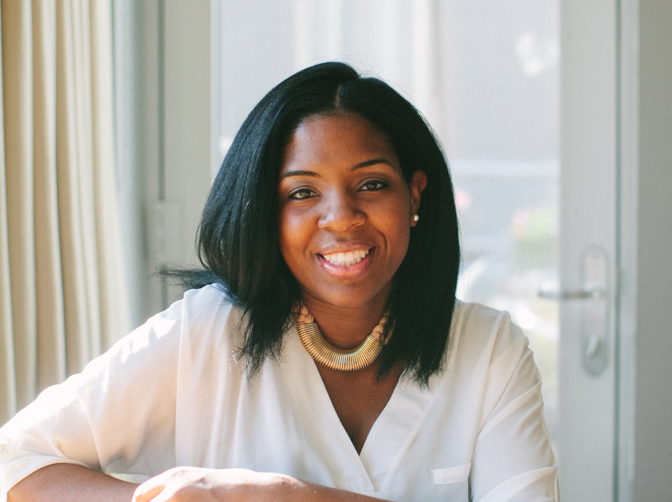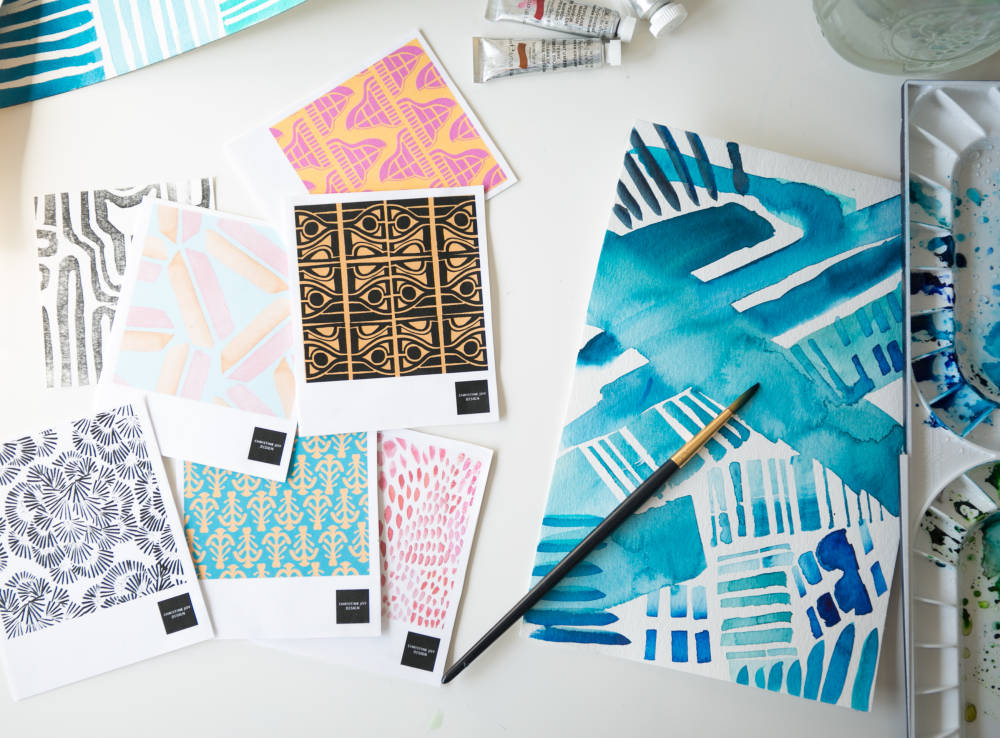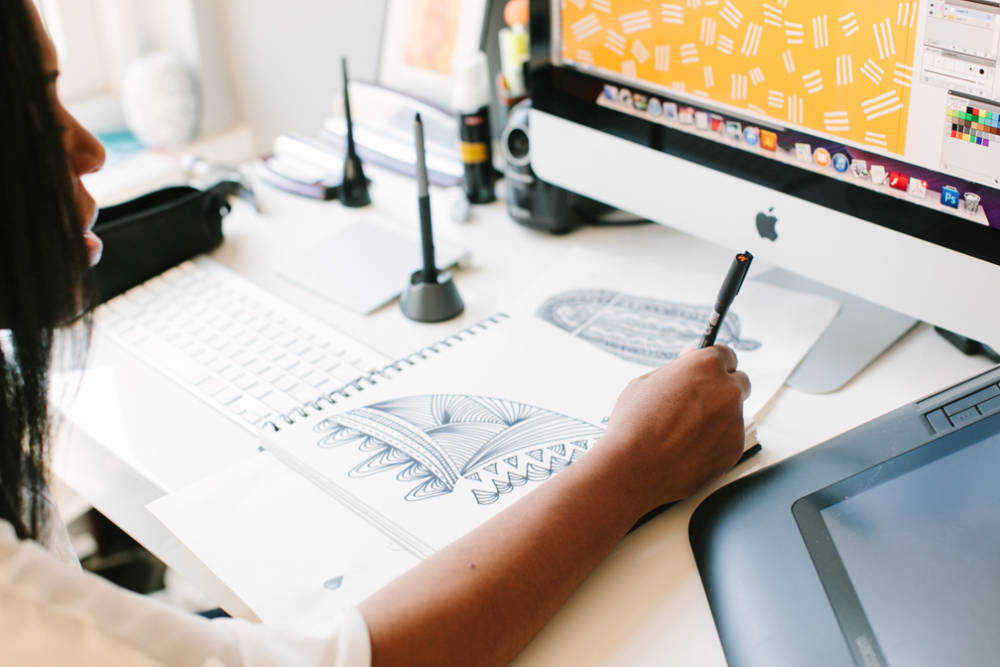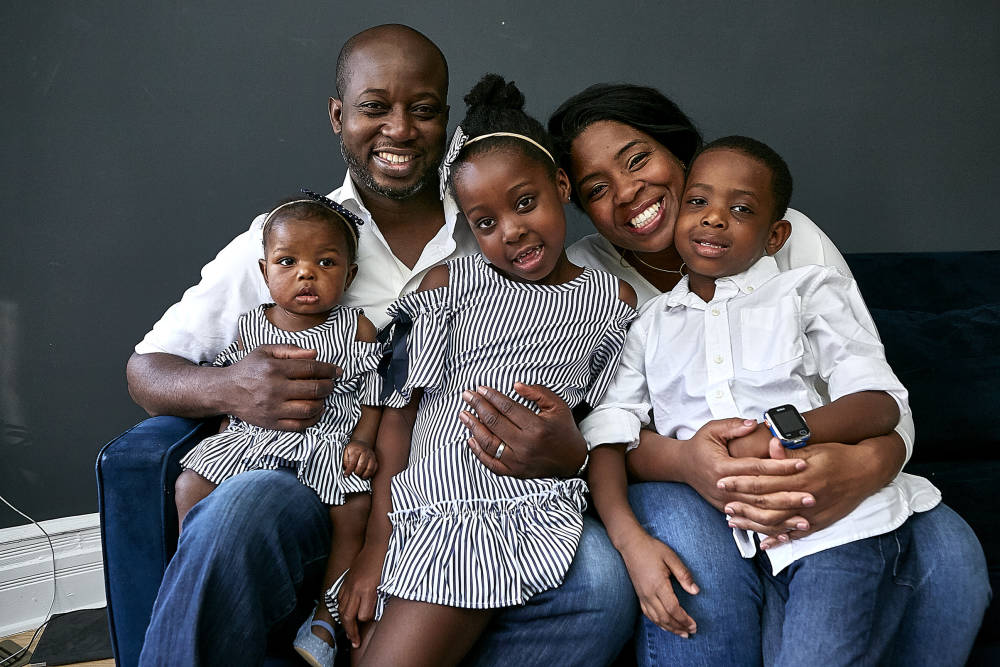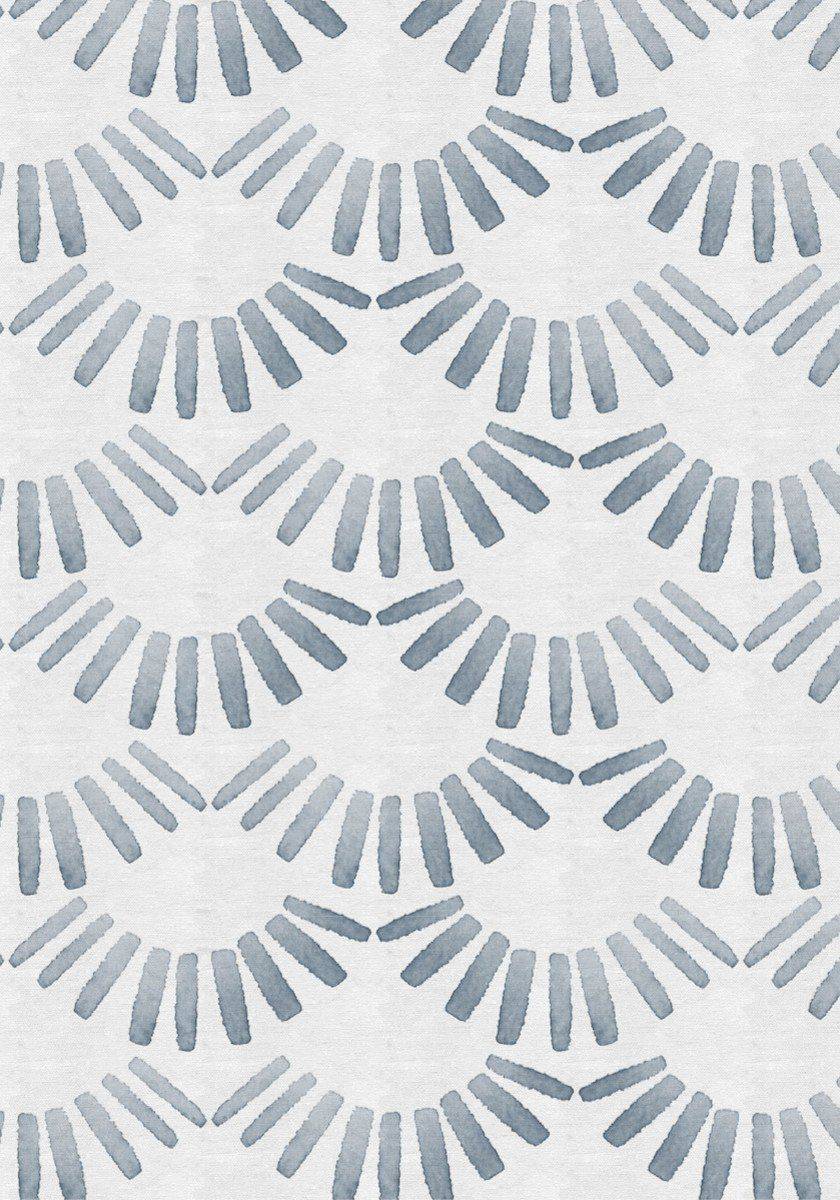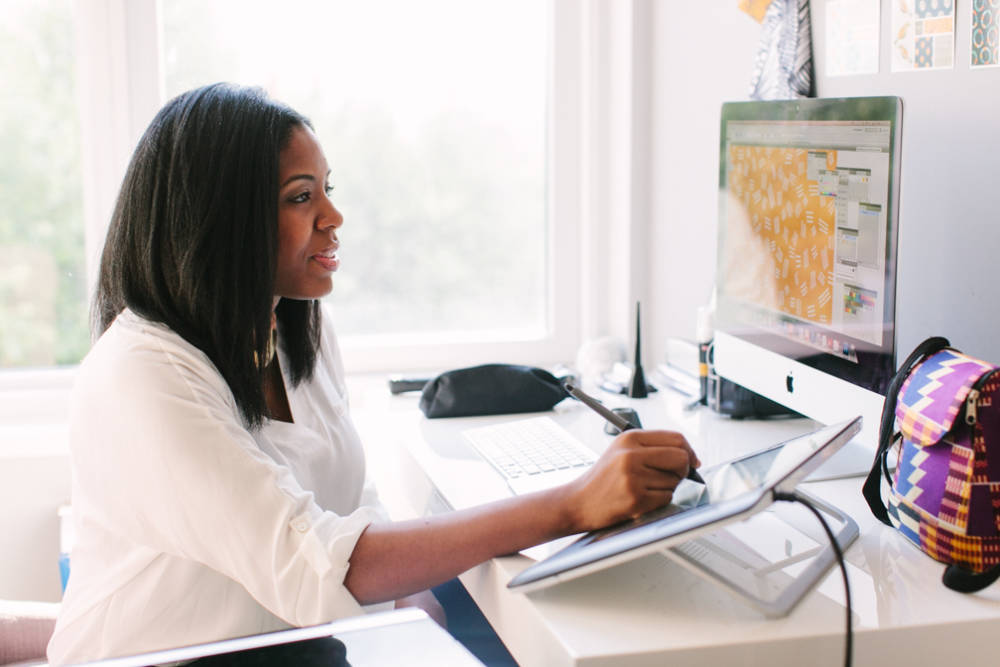What projects are you working on right now? My baby is nine months old now, which is kind of crazy to think, how fast that time has flown by. What I’m doing is taking a step back, and deciding what direction my company should go in, in terms of, how should divvy up the time between the different things that I do?
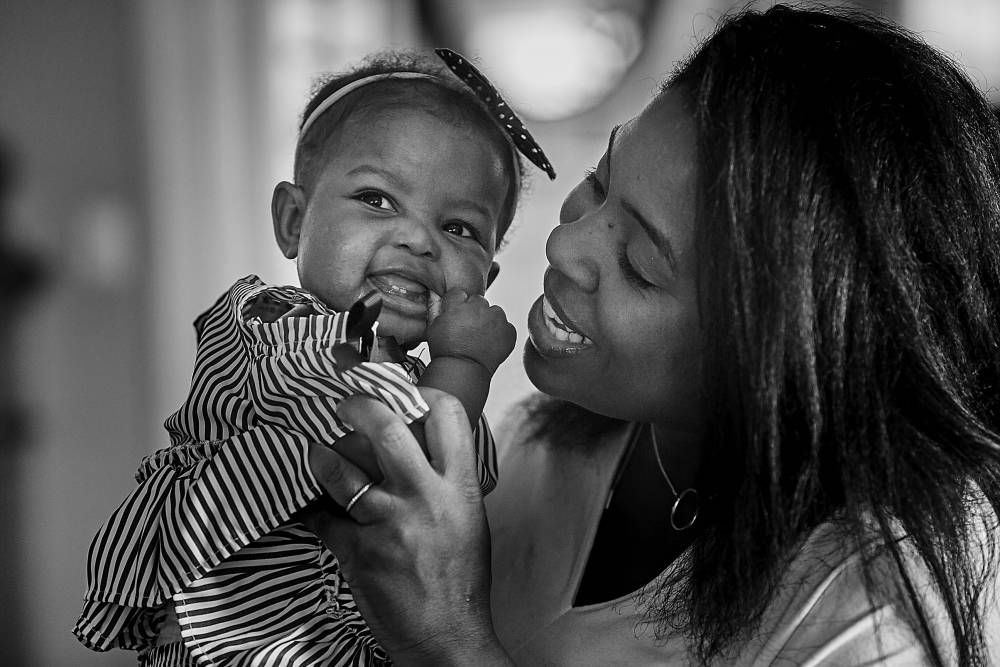
I’m an artist, but I also do surface pattern design, and the way that you go about selling both of those things is very different. I’m at a point where I’m trying to figure out how much time I want to put into both of those. And just having my baby, and sort of being forced to take some time for myself away from my art has allowed me to really think about what I want to do.
It’s sometimes a curse to have so many different interests, and to know where to put your energy at any one time. And then you throw children into the mix and it kind of makes you reevaluate your priorities, right? Exactly, absolutely. One thing that I am excited about that I decided I would do again is a trade show that is focused specifically on the apparel market. Basically this trade show would allow me to get my patterns on apparel, which is something that I’ve done in the past and that is always so exciting for me to see. I’ve had my patterns on different home goods products and on art pieces, which has been exciting. But there’s something about apparel and having somebody walk around with a pattern that you’ve created that excites me a lot.
Between now and then, it’s really going to be cranking out as much work as possible in preparation for this show. This show has been awesome for me, in terms of just connecting me with some of the companies that I’ve been working with, and some of the clients that have come back regularly. So I want to make sure to do a good job at this trade show in July.
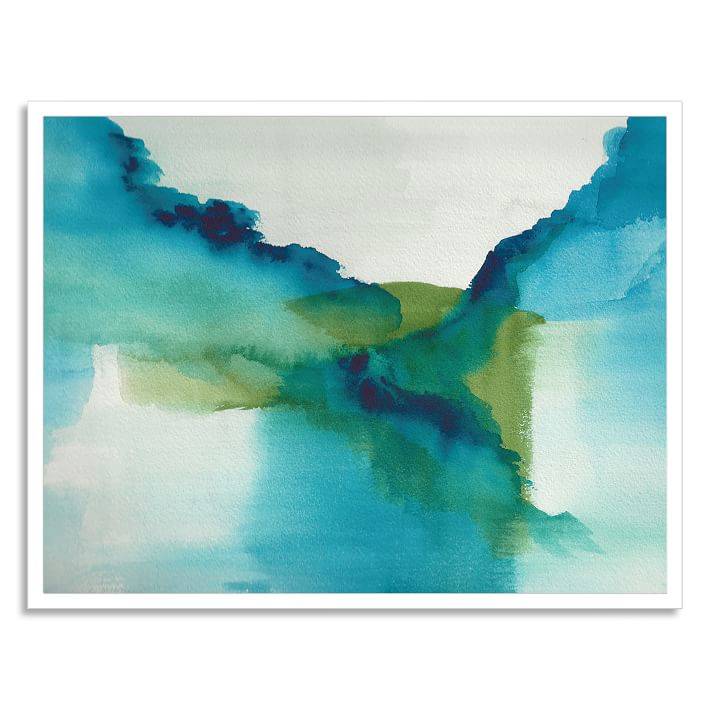
How did you get your interest in pattern design in the first place? I ended up after college doing consulting. I was doing financial consulting at PricewaterhouseCoopers, and loved the people that I met there, but I just knew it wasn’t the right fit for me. I do feel like I’m sort of left brain and right brain, but I felt like my pull toward the creative side is definitely stronger. So I’m going along, my first job out of college, and I remember thinking, I know consulting—especially financial consulting—is not what I want to do. What would allow me to be more creative, but still stay under the business umbrella? I had a lot of people say, “Why don’t you consider marketing? You create promotions, and sometimes you work with creatives, so that might excite you a little bit more.” So I ended up getting my MBA. I focused in marketing. I graduated and started working at American Express.
Looking back, it’s so funny to see how things that seemed sort of random at the time actually made perfect sense, when you look back at where you are now and how you got there. I was put on a project at American Express where I was a project manager for this initiative that was converting the official card of Universal Studios from Visa to AmEx. I was tasked with working with creatives to come up with signage and three dimensional objects that could be in the stores at Universal Studios that would encourage customers to pull out their AmEx, as opposed to their Mastercard or their Visa.
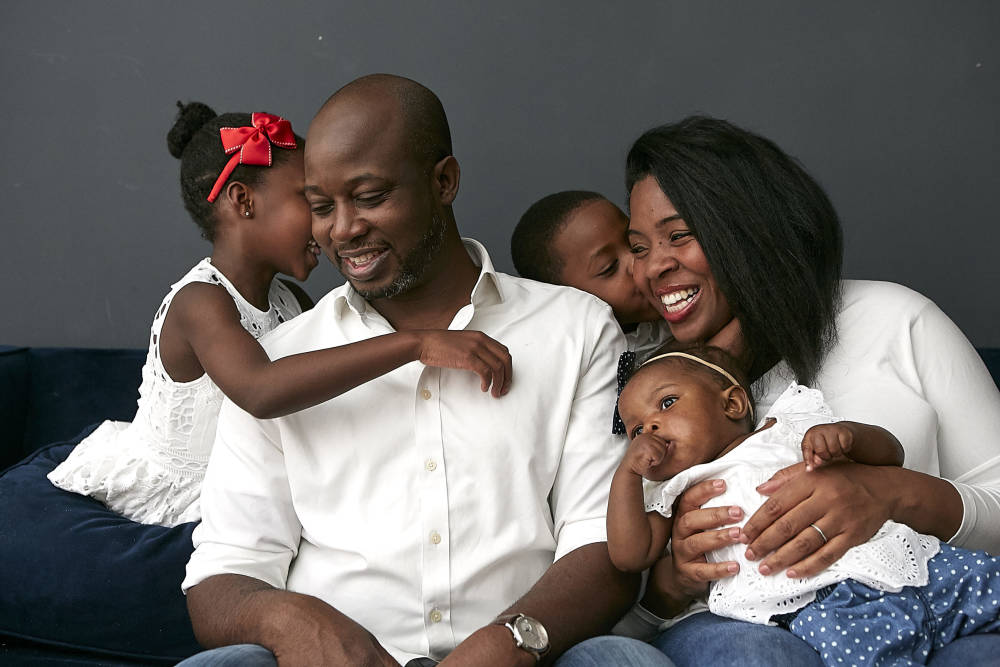
What was exciting about the project, especially now that I look back at it, was I had to basically hire a graphic designer to come up with posters and signage, and I also had to work with an industrial designer to come up with this three dimensional object that would be attached to the registers at Universal Studios. And it just struck me at every meeting that I was in that I was just so much more interested and excited by what they were working on, and less so about what I was working on. Which to me was a lightbulb moment, where I was like, okay, this feels wrong. I should definitely at least explore a creative field. Or, I should take classes after work or do something just to see if this is what I want to do. So I ended up doing that.
I actually credit my being in a creative field right now to this amazing designer called Steven Renk. He has his own graphic design firm. I worked with him on that AmEx project, and he was the one when I was like, “Oh my god, your stuff is so cool.” He was like, “If you’re interested in this, I’ll show you some of the work that I’ve done. I’ll stay behind after one of the meetings and show you my work. And if this is something you’re interested in, I totally encourage you to pursue it. You’re young. There’s nothing that is really stopping you.” So from that moment on, I was pretty much determined to leave AmEx eventually and get on a more creative path.
“Having my first daughter, who is now six, forced me to really reevaluate what I wanted to do with this newly minted degree.”
I ended up leaving AmEx, and I went back to school. I did my Masters of Industrial Design at Pratt Institute in Brooklyn, and pursued that. Fast forward: I was about to graduate the program. I got married, also had my first baby. Having my first daughter, who is now six, forced me to really reevaluate what I wanted to do with this newly minted degree. Now I had this Industrial Design degree. What am I going to do with it?
For awhile, I thought that I would do creative consulting. But then, the more I spoke to people who were actually doing this creative consulting, I realized at the end of the day that you’re basically a consultant, and you’re working long hours, and you’re really beholden to the client. And especially after having my baby and knowing that I really value my time and the time I get to spend at home with her, it made me think, ok. I’m not going to focus on doing any sort of consulting. I’m going to do what I really want to do, but maybe am too afraid to do. And that was basically branching out on my own and creating my own brand.
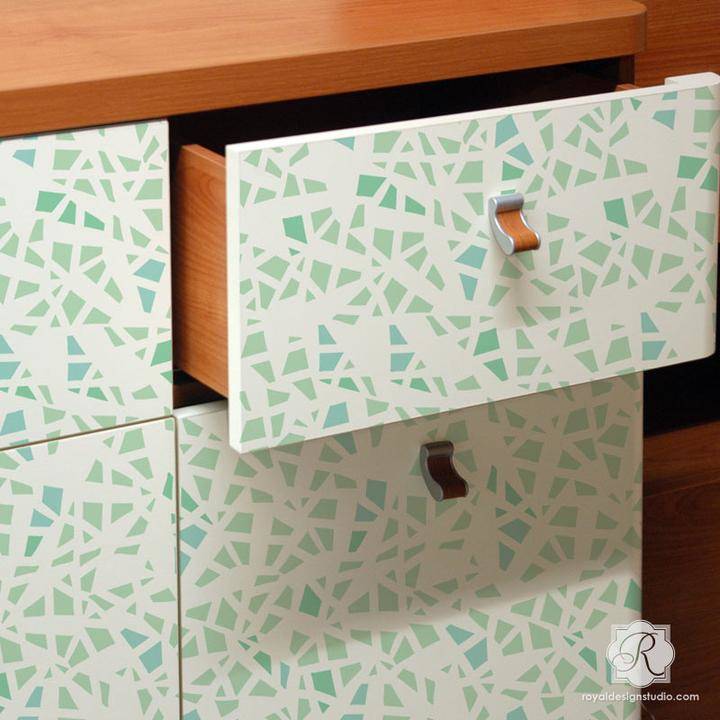
I remember thinking, I have this degree in industrial design. And industrial design is basically product design. The downside of doing product design, especially in a place like Brooklyn, or if you have a smaller apartment, is a lot of things have to be mocked up full scale. For example, I was interested in furniture design, but to really get into that you need a studio space where you can mock things up full scale, and I didn’t have that. But creativity and all these different fields overlap a lot. I was doing a random search online. I came across this course called The Art and Business of Surface Design. And I remember being so intrigued because I had never heard of surface design, even though I had just graduated from this program where I was surrounded by many artists and designers.
I had never heard of surface design. So I did a little digging, and I found out that it is basically creating prints and patterns that get applied to product. So it was sort of an amazing epiphany: Oh my god. There’s this thing that exists that ties together my love of both two dimensional graphic design and product design, and three dimensional surfaces and forms, and wow. I could actually do the flat pattern and have it get applied to this three dimensional surface. So at that point I was like, this sounds perfect. Let me dig into this. Let me dig into this a little deeper. And I did. I took the course actually, and it just felt so right to me. It felt like the perfect marriage of my interests. And that’s sort of where it started.
So that was in 2012, where I sort of discovered surface pattern design. And in 2014 is when I actually decided to go ahead and launch. And how I launched was, I exhibited at this one trade show called Surtex that takes place every year at the Jacob Javits Center. I launched there, and it’s been sort of going ever since. That’s sort of the story as to how I got into surface design.
When you became pregnant and had your baby, how long were you home? And were you doing any work at that time, or did you take time off? I took time off. I had graduated from my program in 2011 from Pratt, and had my baby in 2012. And then I basically took time off, strategizing and figuring out what exactly I wanted to do and how I would launch, and creating a lot of work, and taking that course that I mentioned. Then in 2014 I was able to launch at this trade show. So I wasn’t doing another unrelated job. Thankfully I was in a position where my husband, who has been so amazing and supportive, was like, “Take the time off, figure out what you want to do, and do it.” So that’s what I’ve been doing.
And was it clear for you right away? I’m going to take this time and figure out what I want to do? Or was it kind of tough to be home after working so much. It really was tough. Because I definitely wrestled for awhile with, do I do something in the meantime? I think the whole launching my own thing, or doing my own thing was pretty clear from the get-go, but what I do think I struggled with is, do I just do that? Or, do I do that in conjunction with going back to marketing? And doing that maybe even part time while I figure out this other thing.
To me, financially, it didn’t make too much sense. Just because, let’s say I did decide to go back to work. We would have needed childcare, and childcare, especially in New York City, is not cheap. So it’s like, whatever I would have been making, part time, doing whatever, to me didn’t really make financial sense to go back to work part time, when we would need a sitter. Having come from years of working at these large companies, American Express, and PricewaterhouseCoopers, and knowing so many friends who have done what I did, in that they had babies, but had to go back after four months, it was hard to make that decision. But I also felt like, well, the more time I can dedicate to focusing on creating my own thing and figuring out: What is Christine Joy Design going to be? What is it going to look like? And what is the website going to look like? Just that whole process of creating that brand really made the most sense to focus 100 percent on that, and have it be a strong entry, rather than dabbling in other things and then launching under not the best circumstances, or feeling like I could have done a better job had I focused all my energy on this one thing.
And when you finally did launch, how did you fit it into what you were already doing, staying home with your kids? It was actually really tough. I don’t think I understood how tough it would be. Basically my kids right now are six and five, and they are 17 months apart, so when I launched in May of 2014, I had my daughter who was two at the time, and then my son who was just four months old. And it was really, really hard. I was breastfeeding him, so I was nursing. I also was at this trade show needing to sneak away to a little room in the back where I could pump. So it was just really, really tough. Specifically at the trade show itself, but also with the follow up.
The way it works, especially with surface pattern design, is you do these trade shows. You get in front of these companies. There are no real transactions necessarily that happen on the spot. Sometimes there are. But usually, especially if you’re a new face, they just want to see your style to see if they might want to partner with you. What they’ll do is they’ll take your business card. You get in touch, or they get in touch, and then you find a time to come to their office, where you bring all your prints and patterns and show it to them. They may buy a few. So that whole process was really tough. Not only was the trade show tough, but the after was tough, in just finding time. That’s one thing that you don’t realize. You almost forget. Even with this third baby that I have. I forgot just how hard it is to find a chunk of time where you can focus.
Absolutely. It feels like a luxury when you get more than an hour at one time. Absolutely. So a lot of what you need to do after the trade show is follow up, go to these meetings. They’re happening in person, so you need to find a sitter. There’s just a lot that goes into the after the trade show. And it was hard, especially having two at the time. I feel like it’s almost easier. A lot of people told me it’s almost easier to go from two to three than from one to two. And I definitely found that to be the case, especially having them be so close in age. It’s sort of like I had two babies at home. It was just a juggling act.
Thank goodness we had an amazing sitter at the time who came on Tuesdays and Thursdays. So for me those were my work days where I focused. Even though I could hear them in the other room, at least she would keep them away from the door so I could try to focus as much as possible. That was really helpful, but looking back on it, it was a very challenging time of just trying to really have a strong launch, which I think I did, and trying to keep up the momentum in terms of all of the back and forth that happens after the trade show ends.
I’m thinking a lot right now, in my work, about how to do those transitions. I’m the same way: I’ve got childcare on Tuesdays and Fridays. So then, on Tuesdays I’ve got to jump into being ready to work, and then Wednesdays I have to transition back to being a mom. And it’s like, how do I shift my brain so quickly? But I understand how crucial that was for you, to have those two days to just buckle down and get work done. So crucial. And in fact, I’ve been thinking so much recently, especially now that my younger daughter is nine months old, and especially now that I’ve made the decision to do another trade show in July. I need those two days—at least—a week to just focus and be a hundred percent focused on my work preparing for this show. What’s a little complicated is we recently moved about a year ago, but we still don’t have a sitter, so the whole aspect of finding someone or figuring out a daycare that’s flexible enough where you could just ask for two days a week, so far I haven’t been able to find that. Or finding someone like a nanny. It’s just a lot that needs to happen really quickly to figure out how can I get the amount of time that I need to sufficiently prepare for this upcoming show.
What does life look like for you on a daily basis right now? Are your older ones in school? They’re both in school right now. My daughter is in first grade, so she has a regular day, and also does aftercare, which is nice so I don’t have to rush to pick her up at two-thirty. That’s been a godsend, because I don’t think I could get much done without it. And my son also is in a pre-K program that has the typical hours as well. Luckily they’re at school for a good portion of the day, so it’s just me and the baby that are home. And luckily she’s nine months old, so she is taking naps, but it feels like every week or so she switches up the timing of them to keep things interesting. So that’s been a little tricky. I could never really, really plan too far in advance. Her one-to-two-thirty nap might be three to four-thirty. I just don’t know. But that’s basically what my days look like: get the kids ready, and we all get out the door around seven forty-five. Get my daughter to school for eight. Drop my son off right after that, and then come back home.
It’s just tough now. My daughter is at an age where she wants attention. So it’s a lot of giving her the attention that she needs and playing and trying to get her tired enough to actually nap in the next couple hours. To be honest, a lot of that time that she is napping, I’m really exhausted and all I want to do is nap myself, but a lot of times I just have to take that time and crank out an email, or try to paint or draw or do something. But an hour and a half is really not enough time, and then before you know it, it’s after noon and it’s time to get the kids, and it’s time to think about dinner. There’s laundry that always needs to be done, you know the regular housekeeping type things. So it’s a lot.
It seems like you have put a lot in place. Your business is established enough that it’s not going to disappear if you have to be a mom to the new baby for a year. Totally. Absolutely.
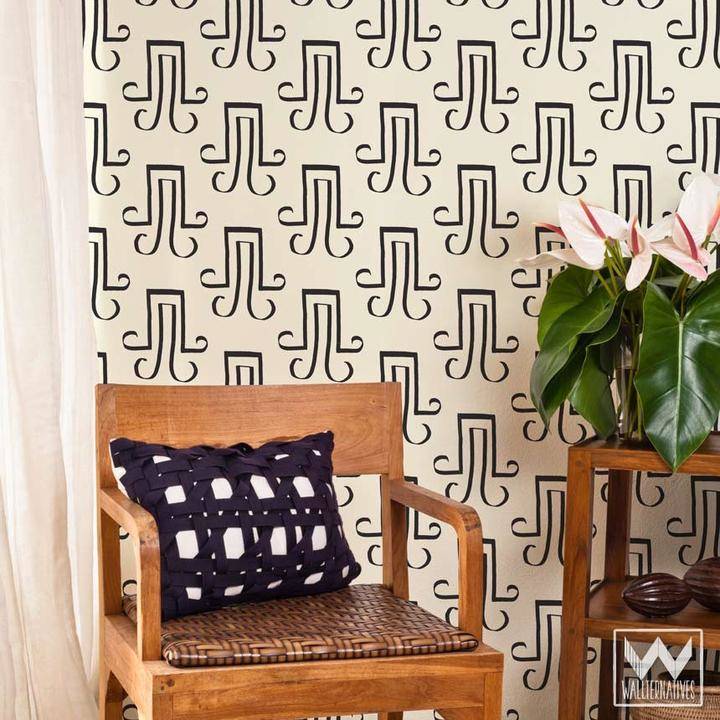
I was reading on your bio that your work is influenced by your mom’s travels when you were growing up. Can you talk about that? My mom worked for the United Nations, and she was in the United Nations Development Program (the UNDP). Every two to three months, she would have to go on a trip that would last about two to three weeks. She was traveling basically only in Asia and Africa, and visiting almost every country. It was just really tough for us as kids, when I think about it. When I knew a trip was coming up, I remember in the days leading up to it just being really sad, knowing how much I was going to miss her in the time that she was gone. I would always look forward to her return. One, because I missed her and I wanted to have her back, but also, she made sure to bring back the most awesome things from the countries that she visited.
“I remember [my mom] brought back this amazing rug from Pakistan that she has in her living room, up until today.”
It was usually stuff for the home. I remember she brought back this amazing rug from Pakistan that she has in her living room, up until today. Whenever she went to any African country, she would bring back these beautiful carvings and statues that she has displayed today. Whenever she went on these trips I would always be so excited to see what she would bring back. And even though they weren’t always things for me, in particular, just seeing what she had to bring and what she would put on display was really, really very exciting.
I’ve found that when I do my drawing and art, and specifically watercolor, I’m also drawn to very bold and graphic prints. I feel like the influence is directly from those types of artifacts that she would bring back from her travels. I can think specifically of this one block print that she had brought back for me from one of her trips. A lot of times when I look at some of my own designs, I think about those things, and I definitely am drawn to that. I think just being in a home surrounded by all of these textiles and furniture from different countries, I had no choice but to be influenced by them, just because that’s what’s ingrained in my memory when I think about home items or rugs or tiles or different things like that.
Is it something that you go into to create something you think, oh I remember this piece that my mom had in our home, or is it something that’s more subliminal? That’s right. What’s so interesting to me is that it’s totally subliminal. I never, ever start out thinking, oh, I want this piece to be influenced by this thing. It always just comes out of me, and then after the fact, I’m like, oh this would fit in perfectly with… It’s not that it necessarily looks exactly the same or anything like that, but just the feel of it, it just to me, feels very much in line with some of these things that I’ve definitely seen in her house, or I grew up with. It’s definitely a subliminal thing, but it’s what brings me most joy. When I create the things I think I’m proudest of or like the most, it is those that have that sort of feel.
It sounds like that was really tough for you as a kid, having your mom gone so often, but that at the same time, you’re honoring that absence through your art now and through your career. How does what your mom did for a career influence the way that you parent? My parents were divorced. They got divorced when I was two. I really don’t have any memory living with my dad, even though he was definitely in the picture. She was the breadwinner. She was very much about her career. My grandma, her mom was the one who really raised us, day-to-day, got us ready for school, that type of thing. She was more like the nurturer, I should say. What’s interesting when I think about my mom, in my mind at least as a kid, is that she was very career focused. When I think about her, or even just overhearing her talk about her career to other people, she was always thinking about the next step, and not so much lingering in what was her current situation.
Let’s say she just got a promotion. She would be happy about it, but not too long after that she would be strategizing: Ok. How do I get to the next level? What do I need to do? Where do I need to be stationed? Always thinking about, “What’s the next step for me?” I just love that about her because that showed me as a child: don’t ever get too complacent. Always be thinking about what’s next on the radar for you, or how you can get to that next level. I think maybe even to a fault, because I find sometimes in my own career, I don’t celebrate enough, and I’m more focused on “What can I achieve next?” But I do think the great thing about having that mindset is it just shows your determination and your drive.
I hope that my kids are seeing that same drive. These are wildly different career paths, but just in my planning for trade shows, thinking about what am I going to do next, what company can I partner with next, who’s on my dream list, how can I make that happen? I hope they see that same type of strategizing and yearning to get to the next level. I definitely think that seeing her strive to get to where she ultimately wanted to be has really affected me and allows me to do the same, and show my kids the same.
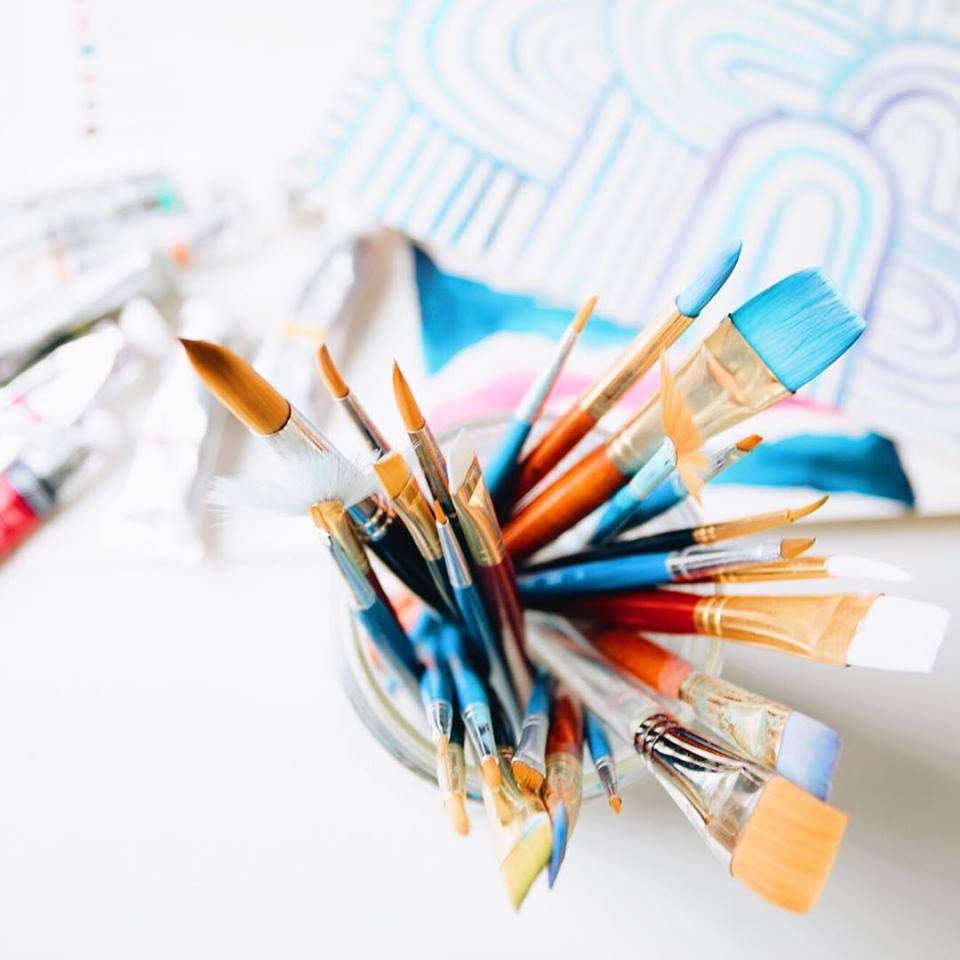
How did you get your work noticed by companies like West Elm and Crate and Barrel? What was that process like? I credit both of those partnerships with the trade shows that I did, especially the ones that I did when I first launched. The way that worked was I was approached at the trade show by a company called Minted. Some company representatives from Minted came up to my booth. I guess they really like the work that I had on display, and said, “I think your aesthetic would really be great for our customers.” They explained how Minted works. Basically they crowdsource what they are going to sell. Their customers vote on the best designs that have been submitted by artists around the world, and the top designs are the ones that get sold.
So they were like,“We love your style. Why don’t you submit to have some of your work sold on Minted.” So I did. I did this one competition and I ended up getting an editor’s pick, which basically means it wasn’t picked by the voting necessarily, but the editors of Minted really liked it. So even though you wouldn’t have gotten in by votes, they liked it enough that they’re going to put you in anyway. For me it was my first competition, and it was really exciting to get this editor’s pick. Then shortly after that I saw that Minted was having a competition with West Elm. Both Minted and West Elm pride themselves in promoting local and independent artists, so it makes sense that they would get together for a competition.
I remember missing the deadline for that, and being like, oh man, I missed the deadline. I’m not going to submit anything, but next year I’m going to keep an eye out and when this competition comes up, I’m going to submit some stuff. Fast forward a year, they announce that their third annual competition is coming up. I remember going to the art store that next day, and being like, ok. I know I want to submit some stuff. I don’t know what. I don’t know what medium, but I love the look of watercolor. I’m going to buy some watercolor paint. I didn’t have any at the time. But I went to Blick, and I bought watercolor paint, and I literally painted. I came home and I painted. I submitted 15 paintings for this competition, and they chose eight of them, which was amazing, just because they’d never selected that many winning pieces by any one artist, ever.
That was amazing. To think that I really had not ever used watercolor. That was not the medium that I was familiar with at all, so to think that I was just sort of playing around, in a sense, and creating this stuff that they really loved was amazing to me. It was just very cool, in and of itself, but also I feel like it was the first thing to me that made me so sure that I was on the right path. This is not just something that I think I like, and I’m not sure that I’m good at. Clearly it’s something that I love doing. I find it so meditative and I love it. But this is something that I’m also good at, and people recognized that, and they agree. It was very affirming. That’s how that happened, with West Elm.
They ended up selling those prints in the store and online, but then they also contacted me about doing this marketing video. They didn’t say why they picked me, but I’m guessing it’s because I had eight that were chosen, and that was awesome. They came to my Brooklyn apartment, and did this video over two days. It was a 20 second video, but it was really cool. They really wanted to get a sense of who I was as an artist, as a person, what my process was, home life, so that was just amazing. I did that, and then Crate and Barrel sort of came out of that.
“I always tell artists who are asking for advice, you really need to leverage the wins that you do get, no matter how small they seem.”
I reached out to someone at Crate and Barrel who randomly had added me on Linkedin. And I was like, I love your company. You’re one of my dream companies to work with. I recently did this stuff with West Elm and Minted. Would you be interested in partnering? And funny enough, this woman was like, “You know, I’m actually retiring next week.” She’s an older woman who worked at Crate and Barrel at their headquarters. She’s like, “I’m actually retiring next week, but I do know the art buyer, and she’s a really good friend of mine. I’ll put you in touch with her.” So she ended up putting me in touch with this art buyer who was like, “I love your stuff. We would absolutely love to launch a collection of your watercolors. So again, it was kind of funny that they decided they wanted me to do watercolors because of this West Elm watercolor competition, when watercolor was just something I was playing around with. I do love working with watercolor, but it was just interesting how that kind of evolved from that one day of being like, oh I want to play around and experiment. So that’s how that happened with Crate and Barrel.
In general, when it comes to both press and actually getting work, it’s amazing how much one thing builds on the other, or how somebody will discover you from seeing you on one bit of press. I don’t know for sure that I would have gotten this deal with Crate and Barrel had I not had my stuff with West Elm. It makes sense, and I always tell artists who are asking for advice, you really need to leverage the wins that you do get, no matter how small they seem. Someone will look at that as a big deal and so definitely don't downplay it. Keep on building on that, until you get to some of the companies that are your dream clients. Keep building on the smaller wins that you get, and definitely don’t minimize them.
How does motherhood inform your artistic choices? I think motherhood definitely informs my artistic choices, in that I find that after having kids I’m a lot more flexible in terms of rules. Not that there are really rules in art, but sort of, especially after going to art school. There are certain sorts of things, like color, theory, and different things that sometimes can be a little restricting, in a sense. When you’re focused too much on those types of theories, or just things that should and shouldn’t be, and I think just seeing how creative my kids are, in that they just don’t care and will do anything, and are just so uninhibited. Their being the way they are has helped me as an artist to also be less structured, and willing to take risks, and willing to just play and invoke some joy and play and freedom into my practice. Not overwhelming myself with the rules or with the trends or with anything like that, but just sort of having fun with whatever I’m doing, and trying to have as much fun as possible.
“We’re keeping someone alive, and to me, that’s pretty important, and that should definitely take precedence. Be easy on yourself.”
What advice do you have for other Mother Makers? Don’t be afraid to just take it slow, and to not feel too rushed and too intimidated by what you see on social media. We as mothers and artists are in such a fragile place. Just having given birth, your hormones are all over the place, and you’re sensitive. It’s a very precious time. And I would just encourage everyone to be gentle with themselves. Yes get on social media, and get inspired, but don’t dwell there. Certainly it’s easier said than done, but don’t compare yourself to other people when you don’t know what their situation is. They may have around the clock help. You just don’t know. I am also saying that as a reminder to myself.
Sometimes it’s hard to login and see all the stuff that people are creating, and just feeling like, “I need to post. Or I need to do this, or I need to do that.” And we’re in such a unique position as artists and as mothers and we need to just be easier on ourselves. If we don’t get a post out in two weeks because we can’t, oh well. We’re keeping someone alive, and to me, that’s pretty important, and that should definitely take precedence. Be easy on yourself. Don’t compare. And limit social media, especially if you’re prone to comparing yourself to others.

